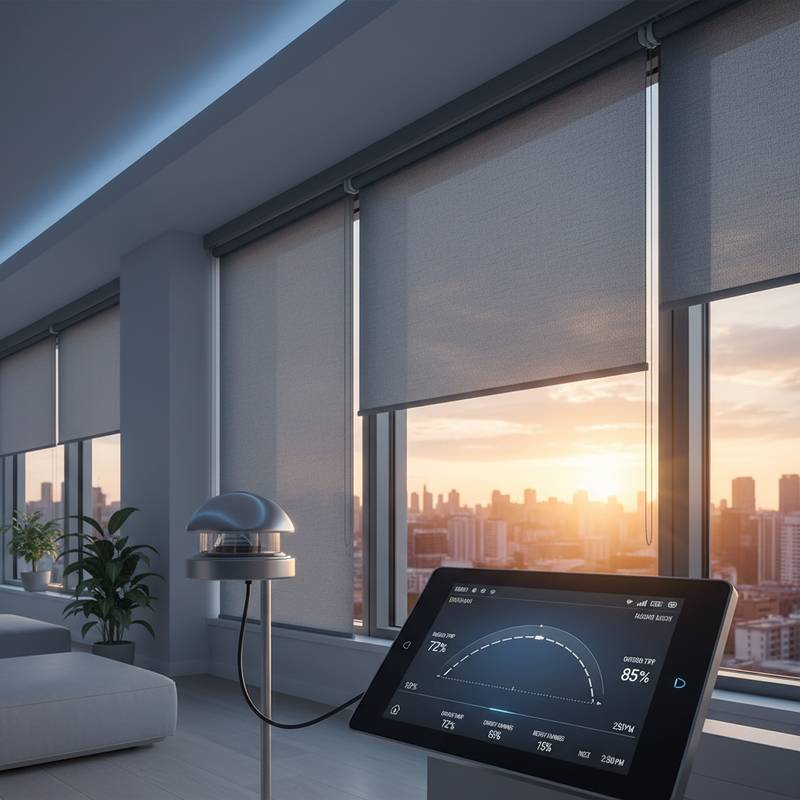Sun-Tracking Smart Blinds Optimize Daily Light and Energy Use
Smart homes advance beyond basic automation to deliver responsive environments. Solar-tracking smart blinds represent a key innovation, adjusting their position every 15 minutes to align with the sun's movement. This technology combines energy savings, thermal comfort, and seamless integration into daily routines.
Consider a bedroom where blinds open gradually at dawn to admit soft light, then reposition midday to diffuse harsh rays. By evening, they lower to preserve warmth and privacy. Such functionality now exists in accessible products, enabling homeowners to achieve balanced interiors with minimal effort.
Challenges of Manual Window Treatments
Traditional blinds demand frequent manual adjustments to manage light and heat. Mornings require opening shades for visibility, while afternoons often involve closing them against glare or overheating. These habits lead to overlooked inefficiencies, such as excessive reliance on electric lights or prolonged air conditioning use.
Data from energy audits indicate that windows contribute up to 30 percent of a home's heating and cooling demands. In regions with variable sunlight, inconsistent shading exacerbates these issues, driving up utility expenses and reducing overall comfort.
Precision Through Automated Sun Tracking
Solar-tracking blinds employ sensors and algorithms to monitor the sun's trajectory relative to each window. Adjustments occur every 15 minutes, tilting slats to admit optimal daylight while minimizing heat buildup. This method ensures even illumination without manual intervention.
The result includes reduced artificial lighting needs by up to 20 percent in well-oriented rooms, alongside protection against fading on carpets and upholstery from ultraviolet rays. Brands such as Somfy offer systems with quiet motors, while Hunter Douglas provides app-controlled variants that sync with geolocation data for accurate positioning.
Users can customize sensitivity through companion apps, setting thresholds for light intensity or temperature triggers. Over time, machine learning refines these patterns based on occupancy and seasonal changes.
Benefits of Frequent, Subtle Adjustments
A 15-minute interval matches the sun's incremental shift, preventing abrupt changes in room conditions. In east-facing living rooms, for example, early adjustments curb morning glare on screens, maintaining productivity without distractions.
Research from building efficiency experts shows that such dynamic controls lower cooling requirements by 15 to 25 percent in temperate zones. For homes with south-facing exposures, the impact proves even greater, as blinds block peak solar intensity during hottest hours.
This rhythm avoids the annoyance of constant movement, operating near silently to preserve a calm atmosphere.
Seamless Connections in Smart Home Networks
These blinds function best within interconnected setups, linking to devices like smart thermostats and motion detectors. Platforms such as Google Home enable voice commands to override automation, while Alexa routines coordinate blinds with lighting scenes.
Upon detecting an empty house via door sensors, the system might fully close shades to deter heat gain and enhance security. Returning occupants trigger partial opening for welcoming light. The Matter protocol further unifies brands, allowing a SwitchBot blind to communicate effortlessly with Philips Hue bulbs.
Setup involves simple pairing via Wi-Fi or Zigbee hubs, with most models supporting over-the-air firmware updates for ongoing improvements.
A Practical Day with Automated Shades
Begin with sunrise in a kitchen: blinds rise incrementally to illuminate countertops without blinding reflections. By 10 a.m., as the sun angles higher, slats tilt to filter light, keeping surfaces cool for meal preparation.
At noon, intensified rays prompt tighter closure, stabilizing room temperature and easing the load on ventilation systems. Afternoon adjustments reopen gradually, promoting natural brightness for reading or relaxation. Nightfall brings full descent, paired with dimmed interior lights for a cozy transition.
App dashboards display adjustment history and energy insights, empowering users to tweak settings for preferences like brighter workspaces or shaded nurseries.
Advancing Sustainability Through Smart Design
Optimized shading directly cuts electricity consumption by favoring daylight over bulbs and easing climate control demands. In summer, closed blinds during peak sun hours prevent indoor temperatures from rising above 72 degrees Fahrenheit, reducing compressor cycles in air handlers.
Advanced units incorporate external solar panels for self-charging, eliminating battery replacements. Paired with weather APIs, they anticipate cloudy days by opening wider to capture available light, maximizing efficiency year-round.
Homeowners report annual savings of 10 to 15 percent on bills, with added longevity for window treatments due to reduced wear from manual handling.
Enhancing Well-Being with Responsive Interiors
Automation frees individuals from routine shade management, allowing focus on meaningful activities. Natural light rhythms support circadian health, with studies linking consistent exposure to improved sleep and reduced stress.
In home offices, steady illumination boosts concentration during video calls. Families benefit from child-safe designs that prevent tangles, while elderly users appreciate hands-free operation via remote controls.
This technology fosters a sense of harmony, where spaces adapt intuitively to enhance mood and productivity.
Addressing Common Concerns for Wider Use
Initial costs range from $200 to $500 per window, but rebates for energy-efficient upgrades often offset expenses. Retrofitting kits attach to existing blinds, requiring no structural changes or professional installation in many cases.
Rechargeable batteries last up to two years, with solar options extending that indefinitely. Compatibility checks via manufacturer apps ensure smooth addition to current ecosystems, minimizing setup time to under 30 minutes.
As production scales, expect further price reductions and broader availability through major retailers.
Steps to Implement Sun-Tracking Solutions
Evaluate your home's sun patterns by noting peak exposure times in key areas. Select models compatible with your hub, prioritizing those with 15-minute tracking for precision.
Test integration in one room before expanding, monitoring energy metrics through built-in logs. Consult local incentives for sustainable tech to maximize returns.
These systems elevate homes into proactive partners, delivering sustained comfort and savings through thoughtful automation.
